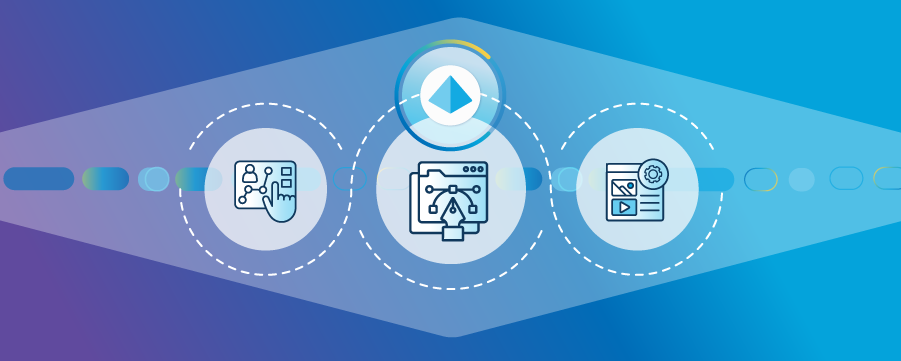What Does Intelligent Document Processing (IDP) Provide?
IDP: Turn Your Unstructured Documents Into Usable, Digital Data

If your organization deals with data and documents – and we’re willing to bet it does – then it’s time to streamline that data with intelligent document processing (IDP). Get better accuracy, security and accessibility by digitizing your paperwork and saying goodbye to hours, days and weeks of monotonous data entry and missing information.
This guide delves into:
- How IDP works, with use cases across industries.
- The benefits of IDP for streamlining processes.
- How IDP fits with other automation technologies.
- How you can get started with an IDP solution today.
How Does Intelligent Document Processing Work?
IDP reads documents, extracts their data and turns it into a structured format – AKA, usable data. By converting this data, IDP makes it machine-readable. This frees your staff from time-consuming, repetitive tasks.
The stages of IDP are:
- Ingesting documents in different formats and from different sources.
- Processing documents by flipping, rotating and/or cleaning them up.
- Classifying documents by intelligently separating and matching them to existing document types.
- Extracting data using trained machine learning (ML) models.
- Validating data accuracy against internal and external data, and applying human-in-the-loop exception review where necessary.
- Integrating data downstream into a variety of tools and applications, including business process management (BPM), robotic process automation (RPA), enterprise resource planning (ERP) and customer relationship management (CRM) systems.
What technologies are involved in IDP?
IDP solutions use artificial intelligence (AI) and optical character recognition (OCR) technology to process all types of documents – structured, semi-structured and sometimes even unstructured – for most processes across most industries.
With further intelligent technologies like natural language processing (NLP), IDP can process documents beyond simple character recognition to have some level of understanding of the converted text.
What is the difference between intelligent document processing and OCR?
IDP incorporates OCR and data capture technologies, but those are a subset of IDP’s capabilities. OCR has been around for a while, extracting text from paper documents, scanned images or photos and converting them into text that a computer can read digitally. But OCR on its own doesn’t understand the meaning of the text it extracts. It focuses on recognizing the characters.
IDP incorporates AI technologies like ML to read and understand what the text means, making it easier to classify and categorize it. For example, it can read an invoice, compare that content to a purchase order, check the amounts for accuracy and then forward it to the right team or department so it can be paid on time.
Fundamentally, OCR is a basic text recognition technology while IDP is much more advanced, using OCR as its base and then adding layers of intelligence – including AI and ML – to classify and process documents with higher accuracy rates than a human.
What Are the Benefits of Intelligent Document Processing?

A large proportion of business data is embedded in unstructured formats such as business documents, images, emails and PDFs. By making this data more accessible, you’re freeing up employee time for higher-value work and ensuring better accuracy and compliance with your data. This makes it easier to automate document processing end-to-end and streamline your business processes enterprise-wide.
With an intelligent document processing software, you get:
- Cost savings: You have fewer expenses thanks to IDP, which reduces the time it takes to process large amounts of data. Decreases in manual staff hours enable a shift in the way operations teams think about work. You can reinvest cost savings in other business areas and reallocate workers to more meaningful activities.
- Accessibility: It’s easier to set up and automate processes with all your data on hand and accurate.
- Productivity: Reduce the manual effort required to process documents. Handling large volumes of documents makes IDP one of the most attractive technologies available for businesses that must adapt quickly to meet throughput demands for large and complex workflows.
- Accuracy: Digital workers are 100% accurate. By automatically extracting and validating data based on specified rules, IDP cuts down on error-prone manual data entry, minimizing costly mistakes and reputational damage.
- Efficiency: Digital workers run 24/7 to get you the data you need across the business. IDP automates many document processing tasks, cutting processing time and reducing the need for manual intervention.
- Strategic automation: Automated data processing helps you focus on higher-value strategic outcomes such as improving customer satisfaction or growing your revenue.
- Compliance: IDP helps ensure compliance with regulatory requirements by safeguarding that data is correct and processed according to predefined regulations.
- Happier customers: In many cases, paper is still preferred or required for customers, agents and brokers. But with IDP, there’s no need to limit customer choice or force customers to go digital. Plus, with faster turnaround times and increased straight-through processing, you can improve your response times to customer inquiries and requests.
What are the benefits of intelligent document processing and RPA?
Robotic process automation (RPA) is a component of the larger automation and orchestration platform, intelligent automation (IA). Together, RPA and IDP simplify the automation process. IDP makes data easier to read and work with, while digital workers can use this data to run automations. This improves straight-through processing and helps you scale your automation faster.
By combining IDP and RPA, you get:
- Faster data processing: IDP-integrated IA tools run faster than any manual processing.
- Lower processing costs: Together, these tools streamline the process of extracting and using data.
- Secure automation: Backed by IA, your data is kept in a secure, centralized location with defined accessibility.
- Enterprise-level scalability: With a fully integrated IA platform, you can seamlessly bring together various systems and information without requiring expensive upgrades.
Where Can You Use Intelligent Document Processing?
Intelligent document processing solutions can be used effectively across departments and industries. IDP can read various text formats and even process barcodes, images and invoices. It scans documents to convert paper-based documents into machine-readable file formats such as PDFs or Microsoft Word, with searchable text options so information is readily available.
Integrated with IA, you can use IDP to pull data from different sources and input it into predefined forms or reports.
IDP lets you extract the right information seamlessly, and then process, store and use it across multiple applications and systems. Manage your documents and data securely with IA and IDP.
Our top-tier IDP solution

We designed our IDP solution with streamlined, optimized and automated processes in mind. SS&C | Blue Prism® Decipher IDP accesses business information quickly and easily by validating and extracting data from structured, unstructured and semi-structured documents. With RPA and OCR working together, Decipher IDP extracts text and text layout information from images and implements it into your business processes.
Our Decipher IDP lets you:
- Customize form templates to validate, format and organize the data entering your systems.
- Design with our easy-to-use no-code automation development so you can start automating faster.
- Set confidence thresholds for data fields, with human-in-the-loop (HITL) verification for exceptional cases.
“If SS&C Blue Prism IDP hadn’t been an option here, the claims department would have to hire
more people. We’ve been able to free up claims assessors so they can do higher-value tasks instead of hiring totally new employees.” Eoin McAndrew, RPA lead, Laya Healthcare
For handwritten documents
Meanwhile, SS&C | Blue Prism® Document Automation turns handwritten documents into decision-ready data – also known as handwriting OCR. That’s for digitizing, classifying and extracting information from paper. And it integrates with our existing automation tools to help you scale more quickly and simplify complex workflows.
Our Document Automation lets you:
- Extract handwriting and low-quality machine print from paper, images and PDFs.
- Accept end-customer information in any form for accurate data extraction.
- Prioritize, contextualize and route data into your current business processes.
Try the 30-day free trial and digitize up to 200 pages today!
Who Should Use Intelligent Document Processing?

Any organization using vast amounts of data and documents will benefit from IDP. IDP reduces manual, repetitive work, improves accuracy and boosts your productivity. Having unstructured data in your business leaves information out of the equation. That’s going to affect decision-making and knowledge transfers.
Use cases by industry for intelligent document processing
Let’s look at how some key industries can benefit from IDP.
Financial services and banking
Banks and other financial services firms process a large volume of documents that require high security. With IDP, you can securely automate paper-heavy processes including:
- Invoices
- Receipts
- Loan applications
- Mortgage applications
- Financial statements
Insurance
Insurance companies can benefit from IDP in their claims processing, policy management and underwriting. IDP extracts relevant information from:
- Insurance forms
- Medical records
- Claims documents
And it extracts critical data such as:
- Case numbers
- License plates
- Customer information
Healthcare
IDP helps healthcare providers extract patient information accurately, facilitate quicker reimbursements and ensure regulatory compliance by extracting information from:
- Medical records
- Billing and insurance forms
- Lab reports
Decipher IDP helped Life Healthcare Group speed up its accounts payable process. Digital workers processed 60% of their invoices, done 10 to 12 times faster with our IDP solution. Read the case study.
Retail and e-commerce
By automating document-intensive processes, IDP helps reduce costs, improve accuracy and enhance customer satisfaction. Retailers and e-commerce companies use IDP for:
- Invoice processing
- Inventory management
- Order fulfillment
- Customer queries and complaints
Manufacturing
In the manufacturing sector, IDP is used to ensure manufacturing operations run smoothly and meet industry standards. They use IDP to deal with heavy volumes of:
- Purchase orders
- Shipping documents
- Bills of lading
Public sector
Government agencies utilize IDP for citizen services, document management and compliance. IDP helps improve citizen services and operational efficiency by processing a massive number of documents, including:
- Applications
- Permits
- Licenses
Bridging the Digital Divide
Attempts to bridge the digital divide have traditionally focused on going paperless. But with many paper-dependent workflows, digitization efforts lead to substantial additions for overhead, like onshore and offshore data entry. Rather than moving directly from paper to paperless workflows, bridge the gap by making your data intake format-agnostic. IDP fits into existing systems and allows businesses to seamlessly implement automation. Let IDP kickstart your automation journey today.
